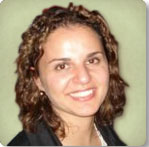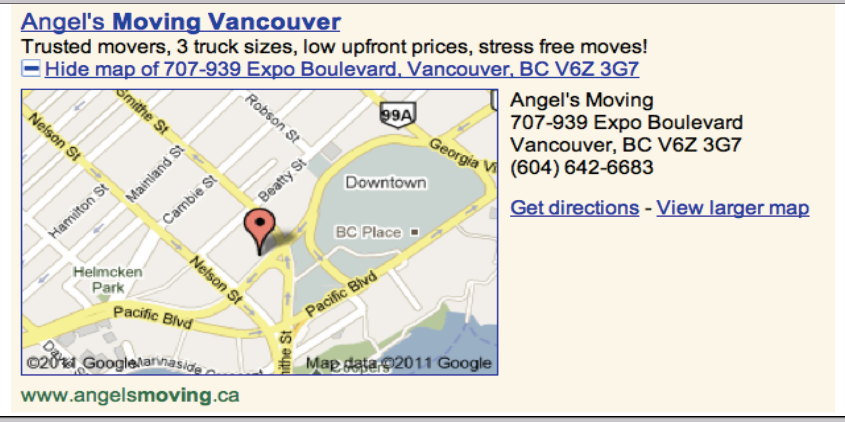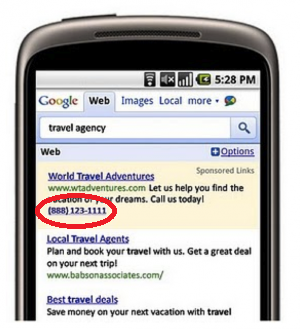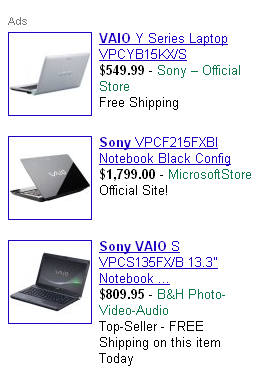
Key Interview Points
As you can see from her bio, Mona has a great deal of expertise in pay per click marketing. We decided to chat about the various types of Ad Extensions for Google AdWords. What makes these interesting is that they can drive a significant increase in click-through rates for your ads. Here are some of the important points that we discussed:
- (Mona) “All the extension products increase the click-through rate. Of course, keep in mind that driving ROI is a completely different story.”
- (Mona) “… you are not charged for clicks that expand the map, but you are charged for clicks that go from the information window to the website.”
- (Mona) “A common mistake people make with AdWords is lumping everything together.”
- (Mona) “With mobile, you want to make sure you are bidding higher and your queries are slightly shorter.”
- (Eric) “It (phone extensions) may not work well for products that people prefer to touch and feel before they buy.”
- (Mona) “Trends work really well for Sitelinks. It’s a way to highlight a new product”
- (Mona) “Compare a Product Extension ad with a normal paid search marketing ad. This attracts more attention.”
- (Mona) “Yes, this is very new and still in Beta. It’s called Communication Ad Extensions. In the ad, Google will display a way in which you can communicate with the business.” What makes this interesting is that Google brokers the communication so the business does not get your contact info during the initial communication.
- (Mona) “The key is to test them (the Ad Extensions) as not everything is going to resonate with all audiences and all products.”
The Location Extension
Eric Enge: Can you tell us about the Location Extension?
Mona Elesseily: The Location Extension shows as an address underneath the ad units. If an ad is positioned at the top of the page, it will have a small plus button beside it that can expand to a map. If it’s one of the smaller units on the right-hand side of the page, the address will be located underneath the display URL.
The larger ad unit shows the address, the map, and the phone number. This information can be pulled from Google Places or advertisers can manually set it up in their Adwords campaign.
For example, when I’m searching for moving companies in Vancouver and find one called “Angel’s Moving Company.” Note that the address is under the ad and there is a plus button to click on.

When you click on the plus button it expands out and shows the map. Google will show you these types of results either based on where you are physically located, or if you include a location name in your search query.

Eric Enge: This is likely to cause a better click-through rate.
All the extension products increase click through rate. Of course, keep in mind that driving ROI is a completely different story.
Mona Elesseily: Yes, all the extension products increase click-through rate. Of course, keep in mind that driving ROI is a completely different story. It’s one thing to get clicks, it’s completely another thing to make money from the clicks you’re getting. If you have two ads at the top of the page, and one has a couple of extension products and another one doesn’t, don’t you think the enhanced ad catches your eye more?
Eric Enge: Yes, because it looks a bit different.
Mona Elesseily: Also, you are not charged for clicks that expand the map, but you are charged for clicks that go from the information window to the website.
Phone extensions and Mobile Campaigns
Eric Enge: Would you talk about Phone extensions?
Mona Elesseily: With a Phone extension you will see a clickable phone number displayed on a phone that has a full browser. The advertiser pays the click cost when they click on the phone number and make the call.

Eric Enge: This is interesting because I’ve seen data that says when people see a phone number they believe the business is more legit.
Mona Elesseily: Another element of that is testing 1-800 numbers versus local numbers. We do many of these tests in an attempt to increase conversion rates. For certain products, people feel more comfortable with an advertiser who is in their backyard. For other products, they are comfortable buying in another state or even halfway across the world.
A common mistake people make with AdWords is lumping everything together.
If you are using the Phone extension in your AdWords campaign, my advice would be to put it into a separate campaign. A common mistake people make with AdWords is not breaking their AdWords into distinct campaigns. For example, they group their content campaigns, their search campaigns, and their mobile campaigns altogether. It’s better to have separate campaigns for each.
Eric Enge: Why is that?
With mobile, you want to make sure you are bidding higher and your queries are slightly shorter.
Mona Elesseily: There are search differences between mobile and desktop. For Example, you are setting up a campaign and you want people surfing on their mobile devices to call you. On mobile, the queries tend to be much shorter and there are a limited number of positions on the mobile search results page. Therefore, you want to make sure your queries are slightly shorter and you are bidding higher for terms. As you know, there are a very limited number of PPC ad spots on mobile devices.
Eric Enge: What do you think the right space is to target for mobile?
Mona Elesseily: That is an interesting conversation. My answer used to be mobile campaigns should be for products you wouldn’t think twice about buying, like a ring tone or movie ticket. However, I recently wrote an article for Search Engine Land on new trends in mobile advertising that questioned this.
People are now using multiple devices at any one time; for example, surfing to get more information on products they are introduced to on TV. It’s not necessarily to make a purchase so that immediate gratification logic has been shattered. The Search Engine Land article has a lot of information on how people use their smartphones today. The space is really changing.
Eric Enge: However, if anyone has a phone-based way of ordering, they should consider an AdWords campaign using the Phone extension, correct?
Mona Elesseily: I’ve used it in some circumstances and it’s worked well but there are circumstances where it hasn’t worked well. Local tends to do well; for example, if you want to call to make an appointment with a chiropractor or order a pizza.
Eric Enge: It may not work well for products that people prefer to touch and feel before they buy.
Mona Elesseily: Like a car, people aren’t buying cars online.
Sitelinks
Eric Enge: Let’s move on to the Sitelinks extension.

Mona Elesseily: Sitelinks are the small hyperlinks you see underneath the ad. The Apple ad above is a good example of this.
Eric Enge: Yes, I see a link for the white iPhone, iPad 2, MacBook Pro and even a Back to School offer. What’s interesting is they seem to be taking advantage of a hot trend like the white iPhone and an iPad with free engraving.
Trends work really well for Sitelinks. It’s a way to highlight a new product
Mona Elesseily: Sitelinks are a good way to highlight a new product or enhance your advertising related to a specific product offering or to drive traffic to your high conversion page or high margin products. Another good use is to segment users. For example, provide different links for business and consumer customers if your business targets them both. I cover this in depth in a Search Engine Land article on Supercharging Your Ads with Sitelinks.
Eric Enge: How does Google determine when and where to show your Sitelinks?
Mona Elesseily: There is a CTR requirement. You are compared against other people in your industry and then Google makes a call as to which ads will display Sitelinks. For the most part they show up for transactional searches. If you do some of these broader generic types of searches, you are not going to see the Sitelinks come up as much. At this point, Sitelinks only show up in the top ad spots and do not show up in ads on the right-hand column.
Eric Enge: Obviously, it’s easier to have your Sitelinks show if you are a recognized brand because your CTR differential would usually be pretty substantial.
Mona Elesseily: Yes, in theory. In practice sometimes it’s slightly different.
Eric Enge: Is there anybody who shouldn’t use Sitelinks?
Mona Elesseily: Good question. I tried a Sitelink for the forum of a very successful website selling in a particular niche. It didn’t convert well. I also tried a Sitelink that was more of a help link than a product link and it didn’t convert well either.
You want to focus on something concrete, not supplemental, like the examples I gave above. Special offers, special promotions (like flowers on Valentine’s Day) are used to drive traffic to products or areas that tend to convert well in your business.
Eric Enge: Right. If you look at our Apple example, we found it on a generic search but the Sitelinks are for specific things you buy now.
Mona Elesseily: Exactly.
Product Extensions
Eric Enge: Which leads us to Product Extensions.
Mona Elesseily: Let’s look at our Sony example and note it’s showing a picture, short description and prices. This is a feed product and feed info is pulled via Google Merchant Center. The Merchant center account is then linked to AdWords in the campaign settings tab.

The feed has to be in XML format and mandatory fields must be filled out. The mandatory fields are: product name/title, product description, landing page link, image link, product ID, the condition of the product (new, used, etc.) and price.
For advertising to trigger accurately we suggest adding an extra column, called adwords_label, and using keywords separated by commas. This helps Google get more specific in serving up specific products to specific ads in your AdWords account. It takes work to set up the feed but it’s worth it in the end.
Eric Enge: Obviously, the picture of the product and the pricing information are awesome.
Compare a Product Extension ad with a normal paid search marketing ad. This attracts more attention.
Mona Elesseily: The larger format takes up more space and attracts more attention so there’s a better chance of visitors clicking on the ad unit. It also presents people with more information/options on what they are looking for right off the bat.
Eric Enge: I think it gets people more engaged in the buying process. They may look at the first one and decide they want a laptop that is more high end. You’ve gotten them thinking about what they really want which can be incredibly valuable.
Mona Elesseily: Again, we see how the use of these extensions can increase CTR. Once you get them in, hopefully, you can continue to engage and they’ll go on to make a purchase.
Communication Extensions
Eric Enge: You have a brand new extension to share with us today.
Mona Elesseily: Yes, this is very new and still in Beta. It’s called Communication Ad Extensions. In the ad, Google will display a way in which you can communicate with the business. It will appear as the second line in the ad copy and will say something like “be contacted by this business” and there will be a request to call hyperlink or an email hyperlink. Advertisers can choose one or both forms of contact from visitors.
With this advertising, Google is going to protect visitor info and advertisers will not be directly given contact information. Google will play middleman with different email addresses and phone numbers.
Eric Enge: Google brokers this from a privacy perspective.
Mona Elesseily: For now it’s only showing up 10% of the time. Google is testing it to see what kind of traction they’ll get.
Eric Enge: And how do you get it?
Mona Elesseily: As it’s in Beta, Google is only offering it to specific advertisers. This product excites me in a couple of different ways. The first is that lead information allows advertisers to directly gauge the impact of their ads and campaigns without fancy tracking. I also like that Google is thinking about customers needs and setting about trying to help customers achieve their goals/needs.
Eric Enge: If you have a business with a local aspect to take phone orders you’ve got five different things you’ve got to do to boost your campaign. If you have a business selling online, there are four things you may do.
Testing and Using the Extensions effectively
Eric Enge: Do you have any recommendations on how to test and implement these Extensions?
The key is to test them as not everything is going to resonate with all audiences and all products.
Mona Elesseily: Do not test too many of the extension products at the same time or you will not be able to effectively attribute gains to any one extension product. Test the different product separately to see what resonates well with your specific audience. For example, you may find that phone extensions work well but Sitelinks do not work so well for your company.
Eric Enge: Would you recommend setting up a new campaign to test the addition of an Extension, along the lines of an AB test?
Mona Elesseily: I’d set up a different campaign and test against similar ads in another campaign with no extension products running. Note: If campaigns are low volume, A/B could take a while to get statistically significant data. If this is the case with a company, I drive all traffic to new ads and compare it to a prior period (same duration of time). It’s not the most scientific but provides good insights to work with. Just be sure not to run tests during peak periods, as data will be very different (skewed) than the data you see in non-peak period times.
Eric Enge: Thanks Mona!
About Mona
For the last 12 years, Mona Elesseily has focused on paid search strategy and conversion improvement. In her career, she has significantly improved campaign performance for brands such as Capital One, CareerBuilder.com, Cathay Pacific and The Jimmy Pattison Group to name a few. She regularly speaks at Canadian, US, and international online marketing events on paid search, landing page optimization, ad copy creation and integrated online marketing strategy. Some of the events Mona presents at include Search Engine Strategies (SES), Search Marketing Expo (SMX), Ad:Tech, Shop.org, the International Marketing Conference (IMC), WebmasterWorld (PubCon) and the International Internet Marketing Association (IIMA).
Mona has written 2 books on Yahoo! and frequently writes for industry publications. She is a columnist for Search Engine Land and also writes for other publications including the Yahoo Search blog, iMedia Connection and the AMA (American Marketing Association). Her industry knowledge is regularly sought after by the business community, including Wall Street analysts; and she’s frequently quoted in respected publications. Mona has served on advisory boards for both Yahoo! Search Marketing and Acquisio Inc and is the Vice President, Online Marketing Strategy for Page Zero Media.
Other Recent Interviews
Vanessa Fox, July 12, 2011
Jim Sterne, July 5, 2011
Stephan Spencer, June 20, 2011
SEO by the Sea’s Bill Slawski, June 7, 2011
Elastic Path’s Linda Bustos, June 1, 2011
SEOmoz’ Rand Fishkin, May 23, 2011
Bing’s Stefan Weitz, May 16, 2011
Matt Mickiewicz, January 8, 2011
ex-Googler Adam Lewis, October 10, 2010
Wordtracker’s Ken McGaffin, August 16, 2010
Bing’s Mikko Ollila, June 27, 2010
Yahoo’s Shashi Seth, June 20, 2010
Majestic SEO Briefing, June 14, 2010
SEOmoz Briefing, June 9, 2010
Localeze Briefing, June 2, 2010
Google’s Carter Maslan, May 6, 2010
Google’s Frederick Vallaeys, April 27, 2010
InfoGroup’s Pankaj Mathur, April 5, 2010
Matt Cutts, March 14, 2010
